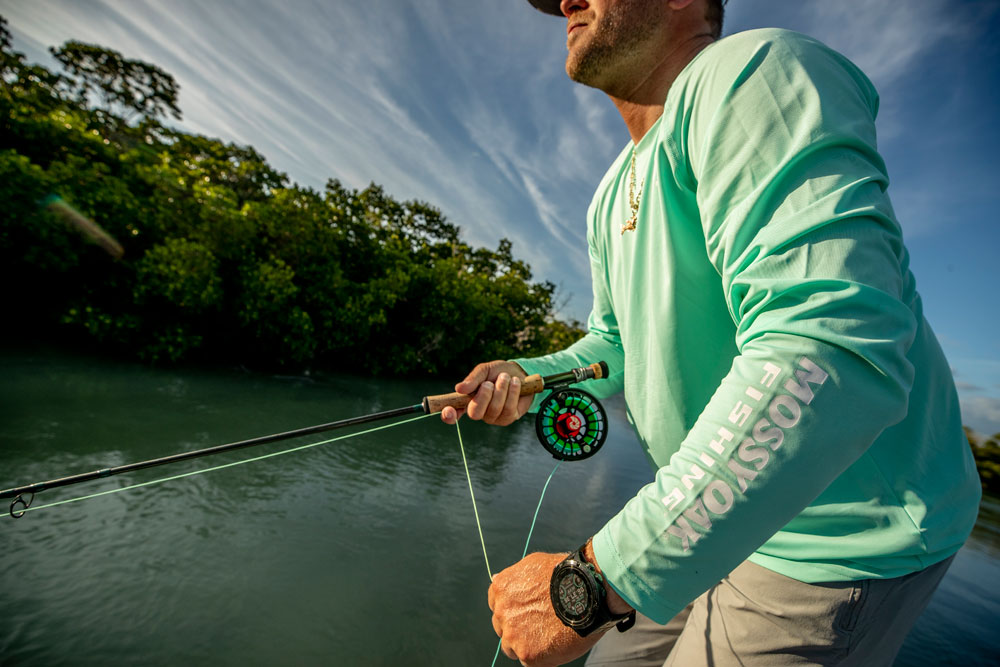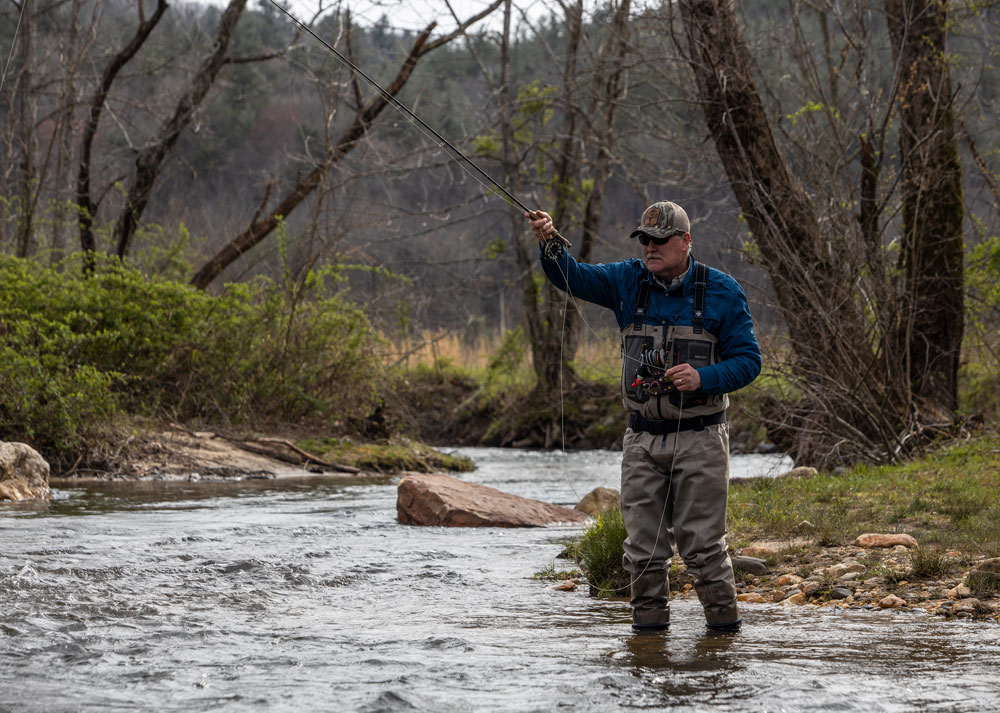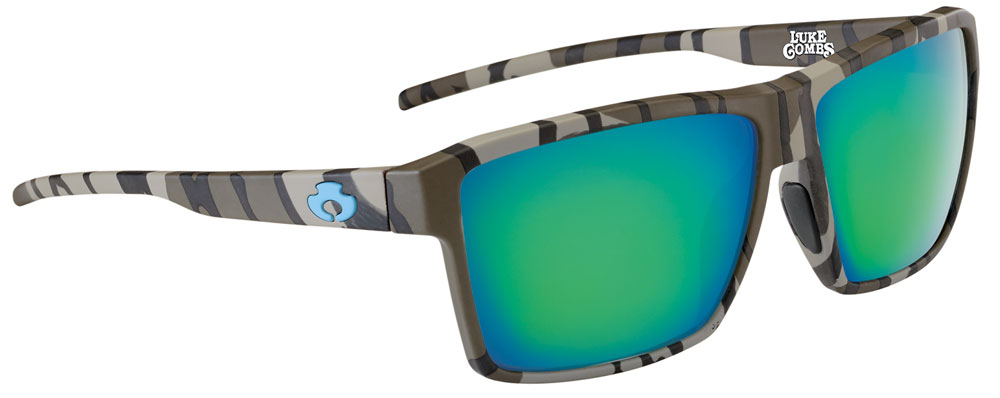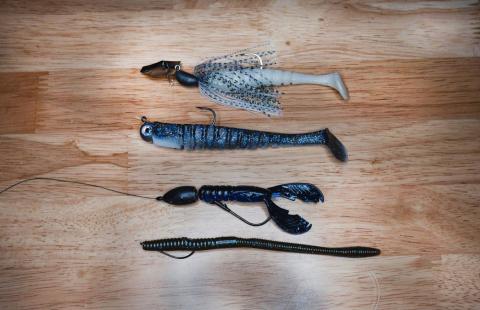Fly fishing can be a serene experience. Just you, the water, and the fish at dawn, breathing in the fresh, brisk air. But without the right clothes and equipment, you might find yourself heading home cold and wet with nothing to show.
If you’re just starting, check out our fly fishing for beginners’ guide to find out the best gear to wear fly fishing and which essential items you need to bring for a successful and stress-free day in the stream.

Looking for fishing gear? Beat back the heat with new Mossy Oak Fishing apparel. Our new fishing shorts are built for superior sun protection, limitless movement and quick dry fabric so you can focus on what matters most.
Best Fly Fishing Clothing
Fishing Hat
A wide-brimmed waterproof fishing hat protects your head and neck from the sun and offers some insect protection. It can also shade your eyes from the water’s glare, giving you better visibility to spot your catch. Ensure that it fits snuggly, without creating too much tension, to stop it from flying off in the wind.
You can also opt for a baseball cap. However, be aware that caps leave your neck exposed, so, if you aren’t wearing a gaiter, you may need extra sunscreen on the back of your neck.
Fishing Vest
The right fishing vest makes organizing your gear simple. Fishing vests have various small pockets, loops, and tags for storing tools and equipment within easy reach. Look for a vest that also has small waterproof pockets to store your wallet or phone in.
Make sure you wear a lightweight, long-sleeve fishing shirt under your fishing vest. Regardless of the temperature, a shirt offers UV protection when you’re standing in a stream under the sun.
Raincoat
Always bring a lightweight raincoat with you. You can keep a small waterproof poncho in your fishing vest in case the weather suddenly changes while you’re on the water.
In addition to a raincoat, pack a fleece. Even if you’re fishing at the height of summer, the weather can be unpredictable, especially in the mountains. If you’re wet and the temperature drops, you need to warm up quickly to avoid hypothermia.
Waders

If you’re only planning to fish from shore, waders may be unnecessary. However, they are a fantastic way to keep you dry if the fish are biting further offshore. Waders are traditionally made from thick, vulcanized rubber, but you can find high-performance, lightweight varieties.
If you plan on fishing in the winter or colder climates, waders keep you warm and dry. Synthetic waders are more lightweight and breathable and are a better option for summer fly fishing.
Make sure your waders come with a belt or suspenders to prevent them from filling with water and becoming a drowning risk.
Wader Boots
Often, your waders will come with wader boots included. These are essential for keeping your footing on slippery rocks and in moving water.
There are many styles of boots, but consider ankle support and comfort. You can choose between rubber, spiked, and felt soles, depending on the underwater terrain.
Essential Fly Fishing Items
Sunglasses
Even if the day starts out cloudy, bring some polarized sunglasses along. The water reflects the sunlight, amplifying it and potentially damaging your eyes. Sunglasses also help you see through the glare and spot more fish.
Fly Fishing Rod and Reel
Choosing your rod and reel depends on many factors, including your destination, the size of fish you expect to catch, and whether you’re fishing small streams or large ones. You’ll need to choose the length of your rod, line weight, and what type of rod action to match your rig.
Leaders and Tippets
You’ll also need leaders and tippets. The leader attaches to the end of your fly line and is anywhere between 7 and 9.5 feet. You’ll tie your fly to the tippet, making it almost invisible to the fish.
Sunscreen
Fly fishermen spend hours in the sun, patiently waiting for a bite. Sunscreen is crucial to protect your skin and prevent melanoma. Ensure your brand is waterproof, a minimum SPF 30, and remember to reapply every 3-4 hours. You can also find sunscreens with moisturizing ingredients to prevent windburn.
Insect Repellant
Slow-moving streams are a breeding ground for mosquitoes and other flying pests. Mosquito bites are irritating and potentially carry disease, depending on your location. Pack a heavy-duty insect repellent spray that eliminates mosquitoes, fleas, and ticks, which are also abundant in fly fishing areas. Don’t forget to reapply your spray as often as your sunscreen.
A Cooler
Bring a big cooler of water, snacks, and enough food for the day to replenish your energy. For cold early mornings, a thermos filled with steaming coffee can make all the difference to your fly fishing experience.
Particularly if you’re fishing in the heat of the day, pack more water than you expect you’ll need. It’s easy to become dehydrated in the sun, causing heat exhaustion. If you are packing ultralight, a portable water filter allows you to create potable water, though you may also need purification tablets if you are fishing in the backcountry.
Flashlight or Headlamp
A fly fishing trip can last from dawn until dusk, depending on how the fish are biting. Always have a flashlight or headlamp with extra batteries on hand. Even if you’re planning on heading home before sunset, plans change, and you do not want to find yourself stranded in the dark.
Emergency Kit
Anytime you head out into the wild outdoors, bring an emergency kit with you. Include allergy and pain medicines, any prescription medications you need, extra contacts or glasses if you wear them, bandaids, hand sanitizer, clean wipes, and a brace. You likely won’t need any of it, but accidents happen and, if you are far from civilization, an emergency kit and knowledge of basic first aid can mean the difference between life and death.
Fishing License
Before you head out, check out your state’s fishing laws. Many require you to purchase a fishing license. The application process, cost, and duration of the licenses vary from state to state and often depend on fish size and species.
With the right clothing and fishing gear, you have the perfect foundation for a thrilling and successful fly fishing adventure.































